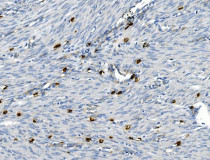ARG43307
anti-CD30 antibody
anti-CD30 antibody for IHC-Formalin-fixed paraffin-embedded sections,Western blot and Human,Mouse
Overview
| Product Description | Rabbit Polyclonal antibody recognizes CD30 |
|---|---|
| Tested Reactivity | Hu, Ms |
| Tested Application | IHC-P, WB |
| Host | Rabbit |
| Clonality | Polyclonal |
| Isotype | IgG |
| Target Name | CD30 |
| Antigen Species | Human |
| Immunogen | Synthetic peptide corresponding to a sequence of Human CD30. (HGNPSHYYDKAVRRCCYR) |
| Conjugation | Un-conjugated |
| Alternate Names | Tumor necrosis factor receptor superfamily member 8; Ki-1 antigen; CD30; Ki-1; Lymphocyte activation antigen CD30; CD antigen CD30; D1S166E; CD30L receptor |
Application Instructions
| Application Suggestion |
|
||||||
|---|---|---|---|---|---|---|---|
| Application Note | IHC-P: Antigen Retrieval: Heat mediation was performed in EDTA buffer (pH 8.0). * The dilutions indicate recommended starting dilutions and the optimal dilutions or concentrations should be determined by the scientist. |
||||||
| Positive Control | Raw264.7 and ANA-1 | ||||||
| Observed Size | ~ 120 kDa |
Properties
| Form | Liquid |
|---|---|
| Purification | Affinity purification with immunogen. |
| Buffer | 0.2% Na2HPO4, 0.9% NaCl, 0.01% Sodium azide and 4% Trehalose. |
| Preservative | 0.01% Sodium azide |
| Stabilizer | 4% Trehalose |
| Concentration | 0.5 mg/ml |
| Storage Instruction | For continuous use, store undiluted antibody at 2-8°C for up to a week. For long-term storage, aliquot and store at -20°C or below. Storage in frost free freezers is not recommended. Avoid repeated freeze/thaw cycles. Suggest spin the vial prior to opening. The antibody solution should be gently mixed before use. |
| Note | For laboratory research only, not for drug, diagnostic or other use. |
Bioinformation
| Database Links |
Swiss-port # P28908 Human Tumor necrosis factor receptor superfamily member 8 Swiss-port # Q60846 Mouse Tumor necrosis factor receptor superfamily member 8 |
|---|---|
| Gene Symbol | TNFRSF8 |
| Gene Full Name | tumor necrosis factor receptor superfamily, member 8 |
| Background | The protein encoded by this gene is a member of the TNF-receptor superfamily. This receptor is expressed by activated, but not by resting, T and B cells. TRAF2 and TRAF5 can interact with this receptor, and mediate the signal transduction that leads to the activation of NF-kappaB. This receptor is a positive regulator of apoptosis, and also has been shown to limit the proliferative potential of autoreactive CD8 effector T cells and protect the body against autoimmunity. Two alternatively spliced transcript variants of this gene encoding distinct isoforms have been reported. [provided by RefSeq, Jul 2008] |
| Function | Receptor for TNFSF8/CD30L (PubMed:8391931). May play a role in the regulation of cellular growth and transformation of activated lymphoblasts. Regulates gene expression through activation of NF-kappa-B (PubMed:8999898). [UniProt] |
| Cellular Localization | Isoform 1: Cell membrane; Single-pass type I membrane protein. Isoform 2: Cytoplasm. [UniProt] |
| Calculated MW | 64 kDa |
| PTM | Phosphorylated on serine and tyrosine residues. [UniProt] |
Images (2) Click the Picture to Zoom In
-
ARG43307 anti-CD30 antibody IHC-P image
Immunohistochemistry: Paraffin-embedded Human endometrial carcinoma tissue. Antigen Retrieval: Heat mediation was performed in EDTA buffer (pH 8.0). The tissue section was blocked with 10% goat serum. The tissue section was then stained with ARG43307 anti-CD30 antibody at 2 µg/ml dilution, overnight at 4°C.
-
ARG43307 anti-CD30 antibody WB image
Western blot: 30 µg of sample under reducing conditions. Raw264.7 and ANA-1 whole cell lysates stained with ARG43307 anti-CD30 antibody at 0.5 µg/ml dilution, overnight at 4°C.







